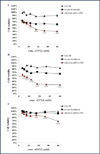Polymeric micelles containing reversibly phospholipid-modified anti-survivin siRNA: a promising strategy to overcome drug resistance in cancer
- PMID: 24099916
- PMCID: PMC3947185
- DOI: 10.1016/j.canlet.2013.09.037
Polymeric micelles containing reversibly phospholipid-modified anti-survivin siRNA: a promising strategy to overcome drug resistance in cancer
Abstract
The discovery that survivin, a small anti-apoptotic protein, is involved in chemoresistance, opens a new scenario to overcome the drug resistance in cancer. It was shown that siRNA can efficiently inhibit the expression of survivin in cancer cells. However, the clinical use of siRNA is still hampered by an unfavorable pharmacokinetic profile. To address this problem, earlier we developed a novel system to deliver siRNA into cancer cells. Namely, we reversibly modified the survivin siRNA with a phosphothioethanol (PE) portion via a reducible disulfide bond and incorporated the resulting siRNA-S-S-PE conjugate into nanosized polyethyelene glycol 2000-phosphatidyl ethanolamine (PEG2000-PE)-based polymeric micelles (PM), obtaining survivin siRNA PM. The activity of these nanopreparations was evaluated by survivin protein down-regulation, tumor cell growth inhibition, and chemosensitization of the treated tumor cells to paclitaxel (PXL). We found a significant decrease of cell viability and down-regulation of survivin protein levels after treatment with survivin siRNA PM in several cancer cell lines. In addition, the down-regulation of survivin by treating cells with survivin siRNA PM, elicited a significant sensitization of the cells to PXL, in both sensitive and resistant cancer cell lines. Finally, we demonstrated successful co-delivery of PXL and survivin siRNA in the same PM leading to superior therapeutic activity compared to their sequential administration. Our results support the use of this new platform for the treatment of the most aggressive tumors.
Keywords: Co-delivery; Multidrug resistance; Paclitaxel; Polymeric micelles; Survivin siRNA.
Copyright © 2013 Elsevier Ireland Ltd. All rights reserved.
Conflict of interest statement
None
Figures






References
-
- Ambrosini G, Adida C, Altieri DC. A novel anti-apoptosis gene, survivin, expressed in cancer and lymphoma. Nat. Med. 1997;3:917–921. - PubMed
-
- Altieri DC. Validating survivin as a cancer therapeutic target. Nat. Rev. Cancer. 2003;3:46–54. - PubMed
-
- Fire A, Xu S, Montgomery MK, Kostas SA, Driver SE, Mello CC. Potent and specific genetic interference by double-stranded RNA in Caenorhabditis elegans. Nature. 1998;391:806–811. - PubMed
Publication types
MeSH terms
Substances
Grants and funding
LinkOut - more resources
Full Text Sources
Other Literature Sources

